MAtlab 傅里叶变换 实验报告
- 格式:docx
- 大小:408.86 KB
- 文档页数:12
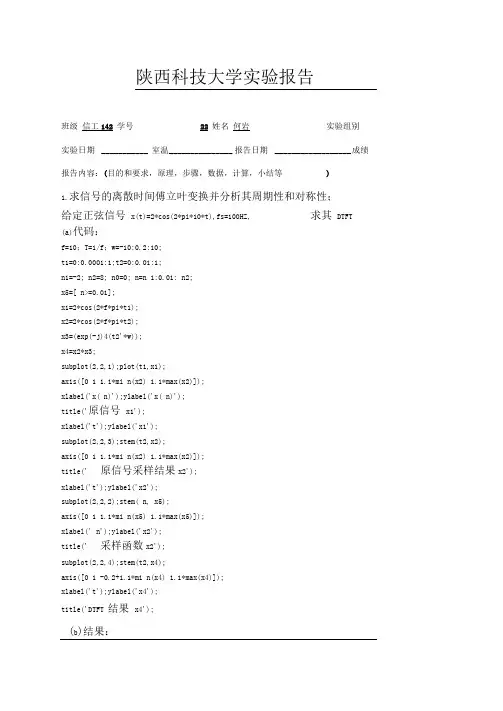
陕西科技大学实验报告班级信工142 学号22 姓名何岩实验组别实验日期___________ 室温_______________ 报告日期__________________ 成绩报告内容:(目的和要求,原理,步骤,数据,计算,小结等)1.求信号的离散时间傅立叶变换并分析其周期性和对称性;给定正弦信号x(t)=2*cos(2*pi*10*t),fs=100HZ, 求其DTFT (a)代码:f=10;T=1/f;w=-10:0.2:10;t1=0:0.0001:1;t2=0:0.01:1;n1=-2; n2=8; n0=0; n=n 1:0.01: n2;x5=[ n>=0.01];x1=2*cos(2*f*pi*t1);x2=2*cos(2*f*pi*t2);x3=(exp(-j)4(t2'*w));x4=x2*x3;subplot(2,2,1);plot(t1,x1);axis([0 1 1.1*mi n(x2) 1.1*max(x2)]);xlabel('x( n)');ylabel('x( n)');title('原信号x1');xlabel('t');ylabel('x1');subplot(2,2,3);stem(t2,x2);axis([0 1 1.1*mi n(x2) 1.1*max(x2)]);title(' 原信号采样结果x2');xlabel('t');ylabel('x2');subplot(2,2,2);stem( n, x5);axis([0 1 1.1*mi n(x5) 1.1*max(x5)]);xlabel(' n');ylabel('x2');title(' 采样函数x2');subplot(2,2,4);stem(t2,x4);axis([0 1 -0.2+1.1*mi n(x4) 1.1*max(x4)]);xlabel('t');ylabel('x4');title('DTFT 结果x4');(b)结果:2.用以下两个有限长序列来验证DTFT勺线性、卷积和共轭特性; x1( n)=[1 2 3 4 5 6 7 8 9 10 11 12];x2( n)=R 10( n)⑴线性:(a)代码:w=li nspace(-8,8,10000);nx仁[0:11]; nx2=[0:9];x1=[1 2 3 4 5 6 7 8 9 10 11 12];x2=[1 1 1 1 1 1 1 1 1 1];x3=[x2,zeros(1,(le ngth(x1)-le ngth(x2)))];x4=2*x1+3*x3;X1=x1*exp(-j* nx1'*w);% 频率特性X3=x3*exp(-j* nx1'*w);% 频率特性X4=x4*exp(-j* nx1'*w);% 频率特性subplot(5,3,1),stem( nx1,x1),axis([-1,13,0,15]);title('x1').n DTFT结果川原信号0 05 1眉信寻采率结臭心ylabel('x (n)');subplot(5,3,2),stem( nx2,x2),axis([-1,13,0,5]);title('x2');subplot(5,3,3),stem( nx1,x4),axis([-1,13,0,26]);title('x4=2*x1+3*x 3');subplot(5,3,4),plot(w,abs(X1)); ylabel(' 幅度') subplot(5,3,7),plot(w,a ngle(X1));ylabel(' 相位') subplot(5,3,10),plot(w,real(X1));ylabel(' 实部') subplot(5,3,13),plot(w,imag(X1)); ylabel(' 虚部') subplot(5,3,5),plot(w,abs(X3)); subplot(5,3,8),plot(w,a ngle(X3)); subplot(5,3,11),plot(w,real(X3)); subplot(5,3,14),plot(w,imag(X3)); subplot(5,3,6),plot(w,abs(X4)); subplot(5,3,9),plot(w,a ngle(X4)); subplot(5,3,12),plot(w,real(X4));subplot(5,3,15),plot(w,imag(X4));(b)结果:⑵卷积:(a )代码:nx1= 0:11; nx2=0:9; nx3=0:20;w=li nspace(-8,8,40); %w=[-8,8]分 10000 份x1=[1 2 3 4 5 6 7 8 9 10 11 12]; x2=[1 1 1 1 1 1 1 1 1 1]; x3=conv(x1,x2);% x1 卷积 x2x4=x1*exp(-j*nx1'*w);% x1 频率特性 x5=x2*exp(-j* nx2'*w);% x2 频率特性 x6=x3*exp(-j*nx3'*w);% x1x7=x4.*x5;卷积x2频率特性subplot(2,2,1),stem( nx1,x1),axis([-1,15,0,15]),title('x1'); subplot(2,2,2),stem( nx2,x2),axis([-1,15,0,5]),title('x2'); subplot(2,1,2),stem(nx3,x3),axis([-1,25,0,80]);title('x1卷积 x2 结xl0 5 10 15l DC 0一叫0 101DCi ----- * ------ n■1Q 0 10^JUQ-"w50 10E■-10 Tin □1U0 ©zZ1010 10果x3');figure,subplot(2,2,1),stem(x4,'filled'),title('x1 的DTFT吉果x4');subplot(2,2,2),stem(x5,'filled'),title('x2 的DTFT吉果x5');subplot(2,2,3),stem(x6,'filled'),title('x3 的DTFT吉果x6');subplot(2,2,4),stem(x7,'filled'),title('x4 的DTFT吉果x7'); figure,subplot(3,2,1),stem(w,abs(x6)). ylabel(' 幅度'),title('x1积x2 的DTFT');subplot(4,2,3),stem(w,a ngle(x6)),ylabel(' 相位')subplot(4,2,5),stem(w,real(x6)),ylabel(' 实部')subplot(4,2,7),stem(w,imag(x6)),ylabel(' 虚部')subplot(4,2,2),stem(w,abs(x7)), title('x1 与x2 的DTFT的乘积');subplot(4,2,4),stem(w,a ngle(x7));subplot(4,2,6),stem(w,real(x7));subplot(4,2,8),stem(w,imag(x7));(b)结果:*1巷视说箔畢內10J5330-100泊的(JTFT结畀汕□10 2 口3Q 4Q⑶共轭:(a )代码:xln=[1 2 3 4 5 6 7 8 9 10 11 12]; w=-10:10;N1= le ngth(x1 n); n1=0:N1-1; x1=real(x1 n); x2=imag(x1 n); x2n=x1-j*x2;X 仁 x2 n*(exp(-j)4( n1'*w)); X2=x1 n*(exp(j)4( n1'*w)); x3=real(X2); x4=imag(X2); X2=x3-j*x4;figure,subplot(211);stem(w,X1,'.');title('x1 n 共轭的 DTFT');subplot(212);stem(w,X2,'.');title('x1 n的 DTFT 取共轭且反折');的「JFTH1三汀的「TFT 笊乘祀(b)结果:-10 -B -S3.求LTI系统的频率响应给定系统H( Z) =B (Z) /A (Z), A=[0.98777 -0.31183 0.0256] B=[0.98997 0.989 0.98997],求系统的幅频响应和相频响应。
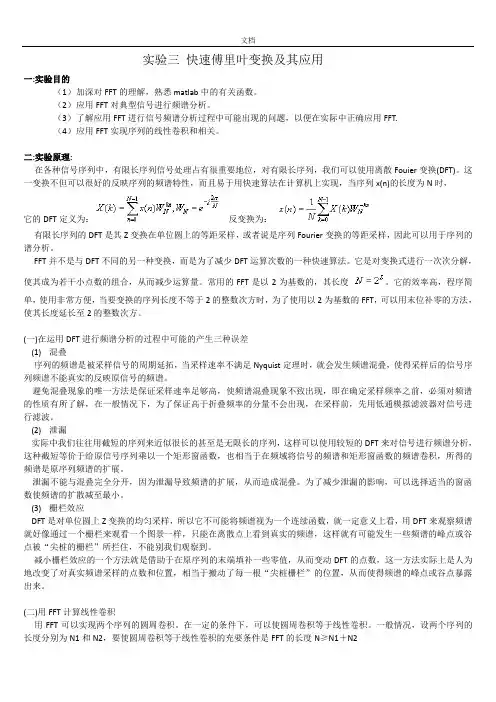
实验三快速傅里叶变换及其应用一:实验目的(1)加深对FFT的理解,熟悉matlab中的有关函数。
(2)应用FFT对典型信号进行频谱分析。
(3)了解应用FFT进行信号频谱分析过程中可能出现的问题,以便在实际中正确应用FFT.(4)应用FFT实现序列的线性卷积和相关。
二:实验原理:在各种信号序列中,有限长序列信号处理占有很重要地位,对有限长序列,我们可以使用离散Fouier变换(DFT)。
这一变换不但可以很好的反映序列的频谱特性,而且易于用快速算法在计算机上实现,当序列x(n)的长度为N时,它的DFT定义为:反变换为:有限长序列的DFT是其Z变换在单位圆上的等距采样,或者说是序列Fourier变换的等距采样,因此可以用于序列的谱分析。
FFT并不是与DFT不同的另一种变换,而是为了减少DFT运算次数的一种快速算法。
它是对变换式进行一次次分解,使其成为若干小点数的组合,从而减少运算量。
常用的FFT是以2为基数的,其长度。
它的效率高,程序简单,使用非常方便,当要变换的序列长度不等于2的整数次方时,为了使用以2为基数的FFT,可以用末位补零的方法,使其长度延长至2的整数次方。
(一)在运用DFT进行频谱分析的过程中可能的产生三种误差(1) 混叠序列的频谱是被采样信号的周期延拓,当采样速率不满足Nyquist定理时,就会发生频谱混叠,使得采样后的信号序列频谱不能真实的反映原信号的频谱。
避免混叠现象的唯一方法是保证采样速率足够高,使频谱混叠现象不致出现,即在确定采样频率之前,必须对频谱的性质有所了解,在一般情况下,为了保证高于折叠频率的分量不会出现,在采样前,先用低通模拟滤波器对信号进行滤波。
(2) 泄漏实际中我们往往用截短的序列来近似很长的甚至是无限长的序列,这样可以使用较短的DFT来对信号进行频谱分析,这种截短等价于给原信号序列乘以一个矩形窗函数,也相当于在频域将信号的频谱和矩形窗函数的频谱卷积,所得的频谱是原序列频谱的扩展。
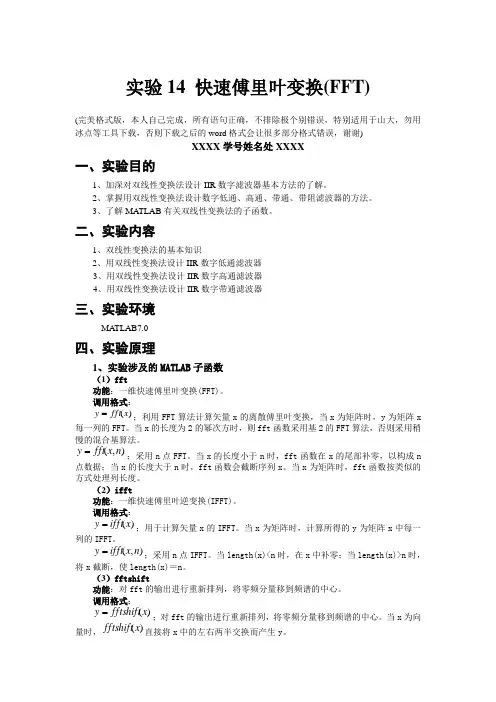
实验14 快速傅里叶变换(FFT)(完美格式版,本人自己完成,所有语句正确,不排除极个别错误,特别适用于山大,勿用冰点等工具下载,否则下载之后的word 格式会让很多部分格式错误,谢谢)XXXX 学号姓名处XXXX一、实验目的1、加深对双线性变换法设计IIR 数字滤波器基本方法的了解。
2、掌握用双线性变换法设计数字低通、高通、带通、带阻滤波器的方法。
3、了解MA TLAB 有关双线性变换法的子函数。
二、实验内容1、双线性变换法的基本知识2、用双线性变换法设计IIR 数字低通滤波器3、用双线性变换法设计IIR 数字高通滤波器4、用双线性变换法设计IIR 数字带通滤波器三、实验环境MA TLAB7.0四、实验原理1、实验涉及的MATLAB 子函数(1)fft功能:一维快速傅里叶变换(FFT)。
调用格式:)(x fft y =;利用FFT 算法计算矢量x 的离散傅里叶变换,当x 为矩阵时,y 为矩阵x每一列的FFT 。
当x 的长度为2的幂次方时,则fft 函数采用基2的FFT 算法,否则采用稍慢的混合基算法。
),(n x fft y =;采用n 点FFT 。
当x 的长度小于n 时,fft 函数在x 的尾部补零,以构成n点数据;当x 的长度大于n 时,fft 函数会截断序列x 。
当x 为矩阵时,fft 函数按类似的方式处理列长度。
(2)ifft功能:一维快速傅里叶逆变换(IFFT)。
调用格式:)(x ifft y =;用于计算矢量x 的IFFT 。
当x 为矩阵时,计算所得的y 为矩阵x 中每一列的IFFT 。
),(n x ifft y =;采用n 点IFFT 。
当length(x)<n 时,在x 中补零;当length(x)>n 时,将x 截断,使length(x)=n 。
(3)fftshift功能:对fft 的输出进行重新排列,将零频分量移到频谱的中心。
调用格式:)(x fftshift y =;对fft 的输出进行重新排列,将零频分量移到频谱的中心。
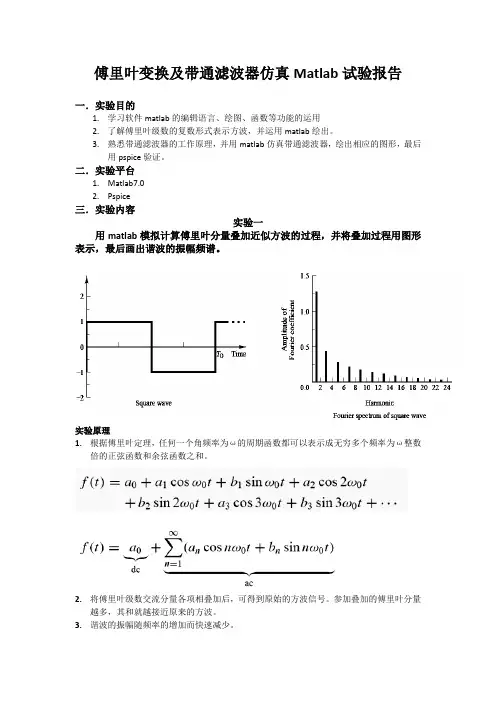
傅里叶变换及带通滤波器仿真Matlab试验报告一.实验目的1.学习软件matlab的编辑语言、绘图、函数等功能的运用2.了解傅里叶级数的复数形式表示方波,并运用matlab绘出。
3.熟悉带通滤波器的工作原理,并用matlab仿真带通滤波器,绘出相应的图形,最后用pspice验证。
二.实验平台1. Matlab7.02. Pspice三.实验内容实验一用matlab模拟计算傅里叶分量叠加近似方波的过程,并将叠加过程用图形表示,最后画出谐波的振幅频谱。
实验原理1.根据傅里叶定理,任何一个角频率为ω的周期函数都可以表示成无穷多个频率为ω整数倍的正弦函数和余弦函数之和。
2.将傅里叶级数交流分量各项相叠加后,可得到原始的方波信号。
参加叠加的傅里叶分量越多,其和就越接近原来的方波。
3.谐波的振幅随频率的增加而快速减少。
实验步骤1.设计叠加傅里叶交流分量的算法。
2.打开Matlab,编辑程序实现算法。
3.运用Matlab的绘图函数将叠加过程用图形表示。
4.用Matlab绘出振幅频谱图。
实验程序代码%时间t从0到2,每隔0.001秒取一点t=0:0.001:pi;y=0;%通过循环绘出a小于等于5和a=16时的图像for a=1:6n=2*a-1y=y+4./(n*pi)*sin(n*pi*t);figure(1)subplot(2,3,a);plot(t,y,'-g')xlabel('Time');ylabel('F');ends=0;for b=1:16s=s+4./((b*2-1)*pi)*sin((b*2-1)*pi*t);endplot(t,s,'-g')%绘出振幅频谱图像figure(2)k=1:2:12;A=4./(k*pi);bar(k,A,0.1);实验结果傅里叶波形图振幅频谱图实验结果分析与结论1.根据傅里叶波形图可以看出,通过逐项叠加傅里叶级数交流分量可以形成原始方波。
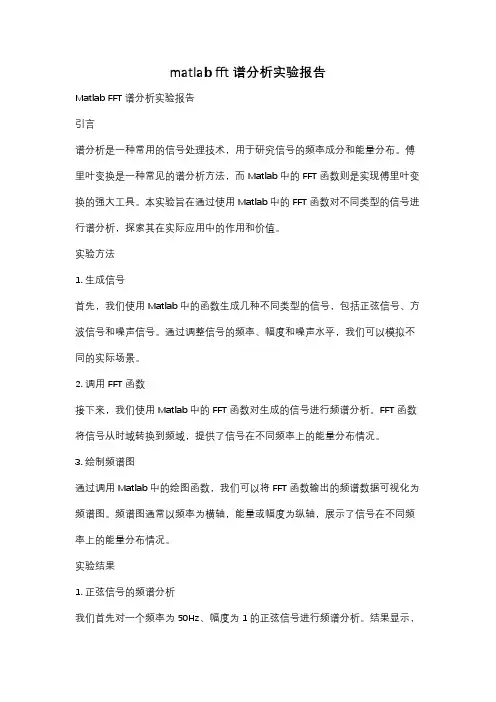
matlab fft谱分析实验报告Matlab FFT谱分析实验报告引言谱分析是一种常用的信号处理技术,用于研究信号的频率成分和能量分布。
傅里叶变换是一种常见的谱分析方法,而Matlab中的FFT函数则是实现傅里叶变换的强大工具。
本实验旨在通过使用Matlab中的FFT函数对不同类型的信号进行谱分析,探索其在实际应用中的作用和价值。
实验方法1. 生成信号首先,我们使用Matlab中的函数生成几种不同类型的信号,包括正弦信号、方波信号和噪声信号。
通过调整信号的频率、幅度和噪声水平,我们可以模拟不同的实际场景。
2. 调用FFT函数接下来,我们使用Matlab中的FFT函数对生成的信号进行频谱分析。
FFT函数将信号从时域转换到频域,提供了信号在不同频率上的能量分布情况。
3. 绘制频谱图通过调用Matlab中的绘图函数,我们可以将FFT函数输出的频谱数据可视化为频谱图。
频谱图通常以频率为横轴,能量或幅度为纵轴,展示了信号在不同频率上的能量分布情况。
实验结果1. 正弦信号的频谱分析我们首先对一个频率为50Hz、幅度为1的正弦信号进行频谱分析。
结果显示,该信号在50Hz附近有一个明显的峰值,表示信号主要由50Hz频率成分组成。
2. 方波信号的频谱分析接下来,我们对一个频率为10Hz、幅度为1的方波信号进行频谱分析。
由于方波信号包含丰富的谐波成分,频谱图中出现了多个峰值,每个峰值对应一个谐波成分。
3. 噪声信号的频谱分析最后,我们对一个包含高斯噪声的信号进行频谱分析。
噪声信号的频谱图呈现出平坦的能量分布,没有明显的峰值。
这说明噪声信号在各个频率上都有一定的能量分布,没有明显的频率成分。
讨论与分析通过对不同类型信号的频谱分析,我们可以得出以下结论:1. 正弦信号的频谱图呈现出一个明显的峰值,表示信号主要由该频率成分组成。
这对于识别和分析周期性信号非常有用。
2. 方波信号的频谱图呈现出多个峰值,每个峰值对应一个谐波成分。
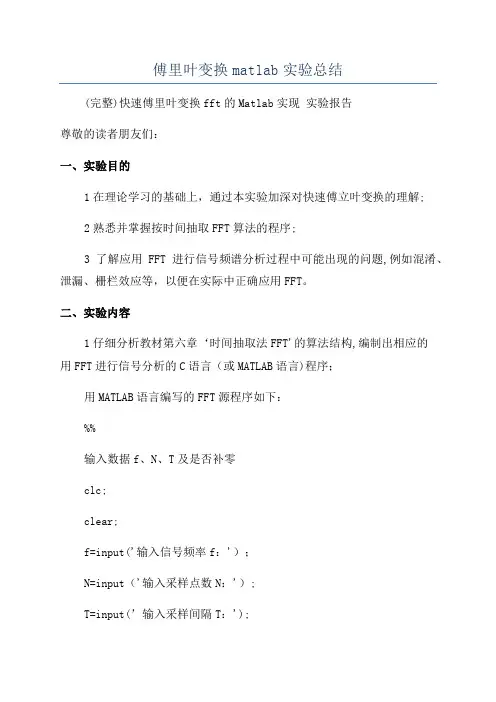
傅里叶变换matlab实验总结(完整)快速傅里叶变换fft的Matlab实现实验报告尊敬的读者朋友们:一、实验目的1在理论学习的基础上,通过本实验加深对快速傅立叶变换的理解;2熟悉并掌握按时间抽取FFT算法的程序;3了解应用FFT进行信号频谱分析过程中可能出现的问题,例如混淆、泄漏、栅栏效应等,以便在实际中正确应用FFT。
二、实验内容1仔细分析教材第六章‘时间抽取法FFT'的算法结构,编制出相应的用FFT进行信号分析的C语言(或MATLAB语言)程序;用MATLAB语言编写的FFT源程序如下:%%输入数据f、N、T及是否补零clc;clear;f=input('输入信号频率f:');N=input('输入采样点数N:');T=input(’输入采样间隔T:');C=input('信号是否补零(补零输入1,不补零输入0):’); %补零则输入1,不补则输入0if(C==0)t=0:T:(N—1)*T;=in(2*pift);b=0;eleb=input(’输入补零的个数:');while(log2(N+b),=fi(log2(N+b)))b=input(’输入错误,请重新输入补零的个数:’);endt=0:T:(N+b—1)*T;=in(2*pi*f*t)。
(t<=(N—1)*T);end%%fft算法的实现A=bitrevorder();% 将序列按二进制倒序N=N+b;M=log2(N);% M为蝶形算法的层数W=ep(—j2pi、N);for L=1:1:M% 第L层蝶形算法B=2^L、2;%B为每层蝶形算法进行加减运算的两个数的间隔K=N、(2^L);%K为每层蝶形算法中独立模块的个数for k=0:1:K-1for J=0:1:B-1p=J2^(M—L);%p是W的指数q=A(k2^L+J+1);%用q来代替运算前面那个数A(k2^L+J+1)=q+W^p*A(k2^L+J+B+1);A(k*2^L+J+B+1)=q—W^p*A(k*2^L+J+B+1);endendend%%画模特性的频谱图z=ab(A);% 取模z=z。
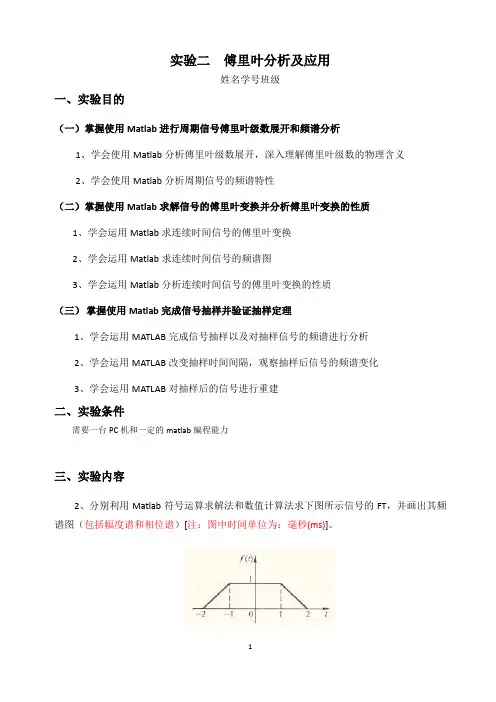
实验二傅里叶分析及应用姓名学号班级一、实验目的(一)掌握使用Matlab进行周期信号傅里叶级数展开和频谱分析1、学会使用Matlab分析傅里叶级数展开,深入理解傅里叶级数的物理含义2、学会使用Matlab分析周期信号的频谱特性(二)掌握使用Matlab求解信号的傅里叶变换并分析傅里叶变换的性质1、学会运用Matlab求连续时间信号的傅里叶变换2、学会运用Matlab求连续时间信号的频谱图3、学会运用Matlab分析连续时间信号的傅里叶变换的性质(三)掌握使用Matlab完成信号抽样并验证抽样定理1、学会运用MATLAB完成信号抽样以及对抽样信号的频谱进行分析2、学会运用MATLAB改变抽样时间间隔,观察抽样后信号的频谱变化3、学会运用MATLAB对抽样后的信号进行重建二、实验条件需要一台PC机和一定的matlab编程能力三、实验内容2、分别利用Matlab符号运算求解法和数值计算法求下图所示信号的FT,并画出其频谱图(包括幅度谱和相位谱)[注:图中时间单位为:毫秒(ms)]。
符号运算法: Ft=sym('t*(Heaviside(t+2)-Heaviside(t+1))+Heaviside(t+1)-Heaviside(t-1)+(-t)*(Heavi side(t-1)-Heaviside(t-2))'); Fw = fourier(Ft); ezplot(abs(Fw)),grid on; phase = atan(imag(Fw)/real(Fw)); ezplot(phase);grid on; title('|F|'); title('phase');3、试用Matlab 命令求ωωωj 54-j 310)F(j ++=的傅里叶反变换,并绘出其时域信号图。
[注意:(1)写代码时j i]syms tFw = sym('10/(3+iw)-4/(5+iw)');ft = ifourier(Fw,t);F = abs(ft);ezplot(F,[-3,3]),grid on;4、已知门函数自身卷积为三角波信号,试用Matlab命令验证FT的时域卷积定理。
![[经验]matlab完成傅里叶变换](https://uimg.taocdn.com/4ed7ec0ac381e53a580216fc700abb68a982adcf.webp)
一、傅立叶变化的原理;(1)原理正交级数的展开是其理论基础!将一个在时域收敛的函数展开成一系列不同频率谐波的叠加,从而达到解决周期函数问题的目的。
在此基础上进行推广,从而可以对一个非周期函数进行时频变换。
从分析的角度看,他是用简单的函数去逼近(或代替)复杂函数,从几何的角度看,它是以一族正交函数为基向量,将函数空间进行正交分解,相应的系数即为坐标。
从变幻的角度的看,他建立了周期函数与序列之间的对应关系;而从物理意义上看,他将信号分解为一些列的简谐波的复合,从而建立了频谱理论。
当然Fourier积分建立在傅氏积分基础上,一个函数除了要满足狄氏条件外,一般来说还要在积分域上绝对可积,才有古典意义下的傅氏变换。
引入衰减因子e^(-st),从而有了Laplace变换。
(好像走远了)。
(2)计算方法连续傅里叶变换将平方可积的函数f(t)表示成复指数函数的积分或级数形式。
这是将频率域的函数F(ω)表示为时间域的函数f(t)的积分形式。
连续傅里叶变换的逆变换 (inverse Fourier transform)为即将时间域的函数f(t)表示为频率域的函数F(ω)的积分。
一般可称函数f(t)为原函数,而称函数F(ω)为傅里叶变换的像函数,原函数和像函数构成一个傅里叶变换对(transform pair)。
二、傅立叶变换的应用;DFT 在诸多多领域中有着重要应用,下面仅是颉取的几个例子。
需要指出的是,所有DFT 的实际应用都依赖于计算离散傅里叶变换及其逆变换的快速算法,即快速傅里叶变换(快速傅里叶变换(即FFT )是计算离散傅里叶变换及其逆变换的快速算法。
)。
(1)、频谱分析DFT 是连续傅里叶变换的近似。
因此可以对连续信号x(t)均匀采样并截断以得到有限长的离散序列,对这一序列作离散傅里叶变换,可以分析连续信号x(t)频谱的性质。
前面还提到DFT 应用于频谱分析需要注意的两个问题:即采样可能导致信号混叠和截断信号引起的频谱泄漏。
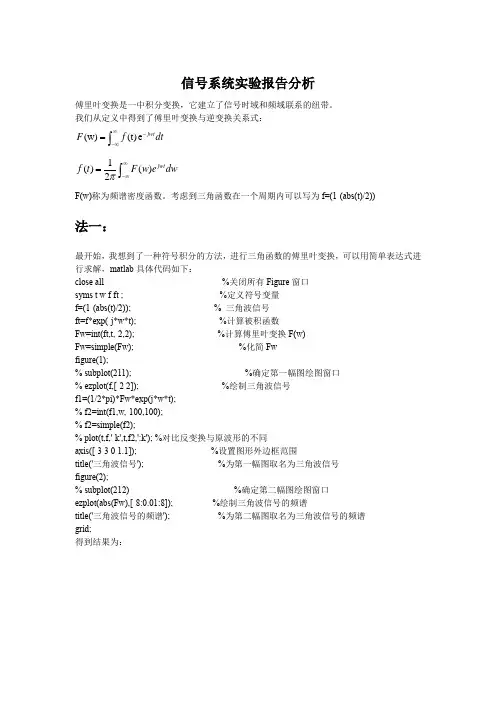
信号系统实验报告分析傅里叶变换是一中积分变换,它建立了信号时域和频域联系的纽带。
我们从定义中得到了傅里叶变换与逆变换关系式:(w)(t)e jwt F f dt ∞--∞=⎰1()()2jwt f t F w e dw π∞-∞=⎰F(w)称为频谱密度函数。
考虑到三角函数在一个周期内可以写为f=(1-(abs(t)/2)) 法一:最开始,我想到了一种符号积分的方法,进行三角函数的傅里叶变换,可以用简单表达式进行求解,matlab 具体代码如下:close all %关闭所有Figure 窗口syms t w f ft ; %定义符号变量f=(1-(abs(t)/2)); % 三角波信号ft=f*exp(-j*w*t); %计算被积函数Fw=int(ft,t,-2,2); %计算傅里叶变换F(w)Fw=simple(Fw); %化简Fwfigure(1);% subplot(211); %确定第一幅图绘图窗口% ezplot(f,[-2 2]); %绘制三角波信号f1=(1/2*pi)*Fw*exp(j*w*t);% f2=int(f1,w,-100,100);% f2=simple(f2);% plot(t,f,'-k',t,f2,':k'); %对比反变换与原波形的不同axis([-3 3 0 1.1]); %设置图形外边框范围title('三角波信号'); %为第一幅图取名为三角波信号figure(2);% subplot(212) %确定第二幅图绘图窗口ezplot(abs(Fw),[-8:0.01:8]); %绘制三角波信号的频谱title('三角波信号的频谱'); %为第二幅图取名为三角波信号的频谱 grid;得到结果为:缺点是,当用Fw进行符号的傅里叶反变换时,matlab提示已经无法进行符号积分了。
所以得不出Fw反变换后的波形。
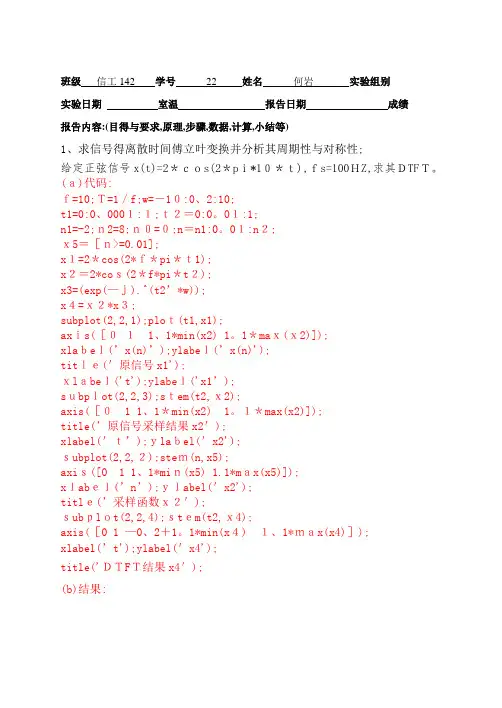
班级信工142 学号22 姓名何岩实验组别实验日期室温报告日期成绩报告内容:(目得与要求,原理,步骤,数据,计算,小结等)1、求信号得离散时间傅立叶变换并分析其周期性与对称性;给定正弦信号x(t)=2*cos(2*pi*10*t),fs=100HZ,求其DTFT。
(a)代码:f=10;T=1/f;w=-10:0、2:10;t1=0:0、0001:1;t2=0:0。
01:1;n1=-2;n2=8;n0=0;n=n1:0。
01:n2;x5=[n>=0.01];x1=2*cos(2*f*pi*t1);x2=2*cos(2*f*pi*t2);x3=(exp(—j).^(t2’*w));x4=x2*x3;subplot(2,2,1);plot(t1,x1);axis([011、1*min(x2) 1。
1*max(x2)]);xlabel(’x(n)’);ylabel(’x(n)');title('原信号x1');xlabel('t');ylabel('x1’);subplot(2,2,3);stem(t2,x2);axis([0 1 1、1*min(x2) 1。
1*max(x2)]);title(’原信号采样结果x2');xlabel('t’);ylabel('x2');subplot(2,2,2);stem(n,x5);axis([0 1 1、1*min(x5) 1.1*max(x5)]);xlabel(’n’);ylabel('x2');title(’采样函数x2');subplot(2,2,4);stem(t2,x4);axis([0 1 —0、2+1。
1*min(x4) 1、1*max(x4)]);xlabel(’t');ylabel('x4');title('DTFT结果x4');(b)结果:2、用以下两个有限长序列来验证DTFT得线性、卷积与共轭特性;(n)x1(n)=[12 3 4 5 6 7 8 9 10 11 12];x2(n)=R10(1)线性:(a)代码:w=linspace(-8,8,10000);nx1=[0:11]; nx2=[0:9];x1=[1 2 3 4 567 8 9 10 1112];x2=[1 1 1 1 1 1 1 1 11];x3=[x2,zeros(1,(length(x1)—length(x2)))];x4=2*x1+3*x3;X1=x1*exp(-j*nx1'*w);%频率特性X3=x3*exp(-j*nx1'*w);%频率特性X4=x4*exp(—j*nx1’*w);%频率特性subplot(5,3,1),stem(nx1,x1),axis([-1,13,0,15]);title('x1’),ylabel('x(n)’);subplot(5,3,2),stem(nx2,x2),axis([—1,13,0,5]);title('x2');subplot(5,3,3),stem(nx1,x4),axis([-1,13,0,26]);title(’x4=2*x1+3*x3');subplot(5,3,4),plot(w,abs(X1)); ylabel('幅度’) subplot(5,3,7),plot(w,angle(X1));ylabel(’相位')subplot(5,3,10),plot(w,real(X1));ylabel(’实部’)subplot(5,3,13),plot(w,imag(X1)); ylabel('虚部’)subplot(5,3,5),plot(w,abs(X3));subplot(5,3,8),plot(w,angle(X3));subplot(5,3,11),plot(w,real(X3));subplot(5,3,14),plot(w,imag(X3));subplot(5,3,6),plot(w,abs(X4));subplot(5,3,9),plot(w,angle(X4));subplot(5,3,12),plot(w,real(X4));subplot(5,3,15),plot(w,imag(X4));(b)结果:(2)卷积:(a)代码:nx1=0:11; nx2=0:9; nx3=0:20;w=linspace(-8,8,40); %w=[—8,8]分10000份x1=[1 2 3 45 6 78 9 10 11 12];x2=[1 1 1 1 1 1 1 1 1 1];x3=conv(x1,x2);% x1卷积x2x4=x1*exp(-j*nx1'*w);% x1频率特性x5=x2*exp(-j*nx2’*w);% x2频率特性x6=x3*exp(-j*nx3'*w);% x1卷积x2频率特性x7=x4、*x5;subplot(2,2,1),stem(nx1,x1),axis([—1,15,0,15]),tit le(’x1');subplot(2,2,2),stem(nx2,x2),axis([—1,15,0,5]),title(’x2’);subplot(2,1,2),stem(nx3,x3),axis([—1,25,0,80]);title('x 1卷积x2结果x3’);figure,subplot(2,2,1),stem(x4,'filled’),title('x1得DTFT结果x4’);subplot(2,2,2),stem(x5,'filled'),title(’x2得DTFT 结果x5’);subplot(2,2,3),stem(x6,'filled’),title(’x3得DTFT结果x6’);subplot(2,2,4),stem(x7,'filled'),title('x4得DTFT结果x7’);figure,subplot(3,2,1),stem(w,abs(x6)), ylabel('幅度’),title(’x1卷积x2得DTFT');subplot(4,2,3),stem(w,angle(x6)),ylabel('相位')subplot(4,2,5),stem(w,real(x6)),ylabel('实部’)subplot(4,2,7),stem(w,imag(x6)),ylabel('虚部’)subplot(4,2,2),stem(w,abs(x7)), title(’x1与x2得DTF T得乘积’);subplot(4,2,4),stem(w,angle(x7));subplot(4,2,6),stem(w,real(x7));subplot(4,2,8),stem(w,imag(x7));(b)结果:(3)共轭:(a)代码:x1n=[1 2 3 4 5 6 7 8 9 1011 12];w=—10:10;N1=length(x1n);n1=0:N1—1;x1=real(x1n);x2=imag(x1n);x2n=x1—j*x2;X1=x2n*(exp(-j)、^(n1'*w));X2=x1n*(exp(j)、^(n1’*w));x3=real(X2);x4=imag(X2);X2=x3—j*x4;figure,subplot(211);stem(w,X1,'.’);title('x1n共轭得DTFT’);subplot(212);stem(w,X2,'、’);title('x1n得DTFT取共轭且反折');(b)结果:3。
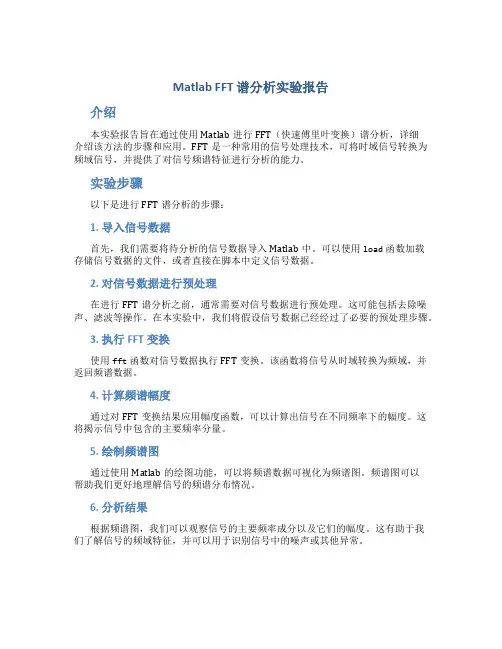
Matlab FFT 谱分析实验报告介绍本实验报告旨在通过使用Matlab进行FFT(快速傅里叶变换)谱分析,详细介绍该方法的步骤和应用。
FFT是一种常用的信号处理技术,可将时域信号转换为频域信号,并提供了对信号频谱特征进行分析的能力。
实验步骤以下是进行FFT谱分析的步骤:1. 导入信号数据首先,我们需要将待分析的信号数据导入Matlab中。
可以使用load函数加载存储信号数据的文件,或者直接在脚本中定义信号数据。
2. 对信号数据进行预处理在进行FFT谱分析之前,通常需要对信号数据进行预处理。
这可能包括去除噪声、滤波等操作。
在本实验中,我们将假设信号数据已经经过了必要的预处理步骤。
3. 执行FFT变换使用fft函数对信号数据执行FFT变换。
该函数将信号从时域转换为频域,并返回频谱数据。
4. 计算频谱幅度通过对FFT变换结果应用幅度函数,可以计算出信号在不同频率下的幅度。
这将揭示信号中包含的主要频率分量。
5. 绘制频谱图通过使用Matlab的绘图功能,可以将频谱数据可视化为频谱图。
频谱图可以帮助我们更好地理解信号的频谱分布情况。
6. 分析结果根据频谱图,我们可以观察信号的主要频率成分以及它们的幅度。
这有助于我们了解信号的频域特征,并可以用于识别信号中的噪声或其他异常。
实验应用FFT谱分析在许多领域中都有广泛的应用。
以下是一些常见的应用领域:1. 信号处理FFT谱分析可用于处理和分析各种类型的信号,例如音频信号、生物医学信号和电力信号等。
通过分析信号的频谱特征,我们可以提取出信号中的重要信息。
2. 通信系统在通信系统中,FFT谱分析可以用于频谱分配、频谱监测和信号调制等方面。
通过分析信号的频谱特征,我们可以更好地设计和优化通信系统。
3. 振动分析FFT谱分析可用于振动分析领域,用于分析和诊断机械系统的振动特征。
通过分析振动信号的频谱,可以检测到机械系统中的故障和异常。
4. 音频处理在音频处理中,FFT谱分析可用于音频信号的频谱分析、音频合成和音频特征提取等方面。
实验二傅里叶分析及应用一、实验目的(一)掌握使用Matlab进行周期信号傅里叶级数展开和频谱分析1、学会使用Matlab分析傅里叶级数展开,深入理解傅里叶级数的物理含义2、学会使用Matlab分析周期信号的频谱特性(二)掌握使用Matlab求解信号的傅里叶变换并分析傅里叶变换的性质1、学会运用Matlab求连续时间信号的傅里叶变换2、学会运用Matlab求连续时间信号的频谱图3、学会运用Matlab分析连续时间信号的傅里叶变换的性质(三)掌握使用Matlab完成信号抽样并验证抽样定理1 、学会运用MATLA完成信号抽样以及对抽样信号的频谱进行分析2 、学会运用MATLA改变抽样时间间隔,观察抽样后信号的频谱变化3 、学会运用MATLA对抽样后的信号进行重建二、实验条件Win7 系统,MATLAB R2015a三、实验内容1、分别利用Matlab符号运算求解法和数值计算法求下图所示信号的FT,并画出其频谱图(包括幅度谱和相位谱)[注:图中时间单位为:毫秒(ms)]。
Code:ft = sym( ' (t+2)*(heaviside(t+2)-heavisi de(t+1))+(heaviside(t+1)-heav iside(t-1))+(2-t)*(heaviside( t-1)-heaviside(t-2))');fw = simplify(fourier(ft));subplot(2, 1, 1); ezplot(abs(fw)); gridon ;title( 'amp spectrum' );phi = atan(imag(fw) / real(fw));subplot(2, 1,2);ezplot(phi); grid on ;title( 'phase spectrum' );Code:dt = 0.01;t = -2: dt: 2;ft(t+2).*(uCT(t+2)-uCT(t+1))+(uCT(t+1)-uCT(t-1))+(2-t).*(uCT(t-1)-uCT(t-2));N = 2000;k = -N: N;w = pi * k / (N*dt);fw = dt*ft*exp(-i*t'*w);fw = abs(fw); plot(w, fw), gridon; axis([-2*pi 2*pi -1 3.5]);符号运算法数值运算法wxphase speetrunn2、试用Matlab 命令求Fj •)1^ -—的傅里叶反变换,并绘出其时域信号图 3 + 他 5 + j co两个单边指数脉冲的叠加Codef = sym( 'heaviside(t+1) - heaviside(t-1)' );fw = simplify(fourier(f)); F = fw.*fw; subplot(211);ezplot(abs(F), [-9, 9]), grid ontitle('FW A2') tri =sym( '(t+2)*heaviside(t+2)-2*t*heaviside(t)+(t-2)*heaviside(t-2)' );Ftri = fourier(tri); F = simplify(Ftri); subplot(212);ezplot(abs(F), [-9, 9]), grid on ;title( 'tri FT' )Code :syms t ; fw =sym( '10/(3+i*w)-4/(5+i* w)');ft = ifourier(fw, t); ezplot(ft), grid on;3、已知门函数自身卷积为三角波信号,试用Matlab 命令验证FT 的时域卷积定理(20 - exp(-3 t) heaviside(t) -8 - exp(-5 t) heaviside(t))/( 2 -■)4、设有两个不同频率的余弦信号,频率分别为匸=100Hz , f^ 3800Hz ;现在使用抽样频率f s =4000Hz 对这三个信号进行抽样, 使用MATLAB^令画出各抽样信号的波形和频谱,并分析其频率混叠现象Code: >t2 = -0.007:ts:0.007; fst = cos(2*f1*pi*t2); fl = 100; % fl = 100 hz>subplot(223);plot(t1, ft, ':'),ts = 1/4000;% sample = 4000hzhold ondt = 0.0001;>stem(t2, fst), gridon ;t1 = -0.007:dt:0.007;axis([-0.006 0.006 -1.5 1.5])ft = cos(2*f1*pi*t1); >xlabel( 'Time/s' ),ylabel( 'fs(t)')subplot(221); plot(t1, ft),grid on ;title( 'Sample sig nal' ); holdoffaxis([-0.006 0.006 -1.5 1.5])>xlabel( 'Time/s' ),ylabel( 'f(t)' )fsw=ts*fst*exp(-1i*t2'*w);title( 'Cos ine curve' );>subplot(224); plot(w, abs(fsw)),grid onN = 5000; k = -N:N;> axis([-20000 20000 0 0.006]) w = 2*pi*k/((2*N+1)*dt);xlabel( '\omega' ),ylabel( 'fsw' )fw = ft*dt*exp(-1i*t1'*w); >title( ' Sample freq spectrum');subplot(222);plot(w, abs(fw)); gridon ;>axis([-20000 20000 0 0.005]);xlabel( '\omega' ), ylabel('f(w)' )>FW 1-8-6^-22468wtri FT-吕 ££€024 68实用文档Cos inecurve-3x 10 Cos freq spectrum-3x 10 Sample freq spectrum Sample signalws4 Time/sx 10-3x 10f1 = 100Hz将代码中f1设为3800即可JCos inecurve-3-1-5! «3254-3x 10 Cos freq spectrumTime/s5X 10-2-10 1©x210Sample signal.I42ws4x 10 Sample freq spectrum-5 0Time/s5-3X 10 x 100 -2f2 = 3800Hz实用文档5、结合抽样定理,利用MATLA编程实现Sa(t)信号经过冲激脉冲抽样后得到的抽样信号f s t及其频谱[建议:冲激脉冲的周期分别取4*pi/3 s、pi s、2*pi/3 s三种情况对比],并利用f s t构建Sa(t)信号(**改动第一行代码即可)t2 = -5: Ts: 5;fst = sin c(t2);subplot(2, 2, 3)plot(t1, ft, ':' ), hold onstem(t2, fst), grid onaxis([-6 6 -0.5 1.2])title( 'Sampli ng sig nal' )Fsw = Ts*fst*exp(-1i*t2'*W);subplot(2, 2, 4)plot(W, abs(Fsw)), grid onaxis([-50 50 -0.05 1.5])title( 'spectrum of Sampling signal' )冲激脉冲的周期=4*pi/3 sSa(t) Sa(t) freq spectrumSampli ng signalspectrum of Sampli ng signalTs = 4/3; % impulse period = 4*pi/3t1 = -5:0.01:5;ft = si nc(t1);subplot(2, 2, 1)plot(t1, ft), grid onaxis([-6 6 -0.5 1.2]) title( 'Sa(t)' )N = 500; k = -N: N;W = pi*k / (N*0.01);Fw = 0.01*ft*exp(-1i*t1'*W);subplot(2, 2, 2)plot(W, abs(Fw)), grid onaxis([-30 30 -0.05 1.5])title( 'Sa(t) freq spectrum' )实用文档冲激脉冲的周期=pi s冲激脉冲的周期=2*pi/3 sSa(t) Sa(t) freq spectrumSampli ng signalspectrum of Sampli ng signalSa(t) Sa(t) freq spectrumSampli ng signalspectrum of Sampli ng signal实用文档6、已知周期三角信号如下图所示[注:图中时间单位为:毫秒(ms)]:(1)试求出该信号程实现其各次谐波[如1、3、5、13、49]的叠加,并验证其收敛性;a。
MAtlab-傅里叶变换-实验报告(最新-编写)一、实验目的1. 了解傅里叶变换的基本概念及其在信号处理中的应用;2. 掌握使用Matlab软件进行傅里叶变换的方法;3. 通过实验掌握傅里叶变换的计算与图像分析方法。
二、实验原理1. 傅里叶级数傅里叶级数是一类振幅、频率和相位相同的正弦(余弦)函数构成某一周期函数的和。
若函数f(t)可以表示为周期2π的函数,则有:f(t) = a0 + ∑[an*cos(nwt) + bn*sin(nwt)] (1)其中,a0、an、bn为常数,w=2π/T为角频率,T为周期。
傅里叶级数引入相位角,使得函数形态可以更加丰富,而且描述更加直观。
假设n=0时,a0是函数f(t)的常数项,且an、bn分别表示f(t)的奇、偶对称部分的振幅,即:a0 = (1/2π)∫[f(t)]dt,an = (1/π)∫[f(t)*cos(nwt)]dt,bn =(1/π)∫[f(t)*s in(nwt)]dt式中,*为乘积,∫为积分。
在时域中,傅里叶分析用来分析周期性信号的性质。
但是,在实际应用中,很少有真正的周期性信号,因此需要将傅里叶分析推广到非周期性信号上,即傅里叶变换。
原信号可以表示为一个函数f(t),其傅里叶变换可以表示为:F(w) = ∫[f(t)*e^(-jwt)]dt其中,j为虚数单位,w为角频率。
傅里叶变换将信号从时域变换到频域,通常使用复数表示幅值与相位。
同时,傅里叶变换也具有很高的线性性质。
即,若有两个函数f1(t)和f2(t),其傅里叶变换分别是F1(w)和F2(w),则下列变换同样成立:a1*f1(t) + a2*f2(t)的傅里叶变换为a1*F1(w) + a2*F2(w)其中,a1、a2为常数。
最后,傅里叶变换的性质包括线性、平移、频移、反褶和自相关性等,这些性质都对信号处理和分析具有实际意义。
三、实验内容本实验主要分为两个部分:1. 计算周期波形的傅里叶级数并绘制其频谱图和振幅谱图。
.实验二傅里叶分析及应用一、实验目的(一)掌握使用Matlab进行周期信号傅里叶级数展开和频谱分析1、学会使用Matlab分析傅里叶级数展开,深入理解傅里叶级数的物理含义2、学会使用Matlab分析周期信号的频谱特性(二)掌握使用Matlab求解信号的傅里叶变换并分析傅里叶变换的性质1、学会运用Matlab求连续时间信号的傅里叶变换2、学会运用Matlab求连续时间信号的频谱图3、学会运用Matlab分析连续时间信号的傅里叶变换的性质(三)掌握使用Matlab完成信号抽样并验证抽样定理1、学会运用MATLAB完成信号抽样以及对抽样信号的频谱进行分析2、学会运用MATLAB改变抽样时间间隔,观察抽样后信号的频谱变化3、学会运用MATLAB对抽样后的信号进行重建二、实验条件Win7系统,MATLAB R2015a三、实验内容1、分别利用Matlab符号运算求解法和数值计算法求下图所示信号的FT,并画出其频谱图(包括幅度谱和相位谱)[注:图中时间单位为:毫秒(ms)]。
..Code:'ft =sym((t+2)*(heaviside(t+2)-heaviside(t+1))+(heaviside(t+1)-heaiside(t-1))+(2-t)*(heaviside)t-1)-heaviside(t-2))fw = simplify(fourier(ft));subplot(2, 1, 1)ezplot(abs(fw)); grid on);'amp spectrum'title(real(fw));phi / = atan(imag(fw)subplot(2, 1, 2);;on ezplot(phi); grid);title('phase spectrum'符号运算法Code:dt = 0.01;t = -2: dt: 2;=ft(t+2).*(uCT(t+2)-uCT(t+1))+(uCT(t+1)-uCT(t-1))+(2-t).*(uCT(t-1)-uCT(t-2)); N = 2000;k = -N: N;w = pi * k / (N*dt);fw = dt*ft*exp(-i*t'*w);fw = abs(fw);plot(w, fw), grid on;axis([-2*pi 2*pi -1 3.5]);数值运算法..104?的傅里叶反变换,并绘出其时域信号图。
MATLAB实验傅里叶分析实验七 傅里叶变换一、实验目的傅里叶变换是通信系统、图像处理、数字信号处理以及物理学等领域内的一种重要的数学分析工具。
通过傅里叶变换技术可以将时域上的波形分 布变换为频域上的分布,从而获得信号的频谱特性。
MATLAB 提供了专门的函数fft 、ifft 、fft2(即2维快速傅里叶变换)、ifft2以及fftshift 用于实现对信号的傅里叶变换。
本次实验的目的就是练习使用fft 、ifft 以及fftshift 函数,对一些简单的信号处理问题能够获取其频谱特性(包括幅频和相频特性)。
二、实验预备知识1. 离散傅里叶变换(DFT)以及快速傅里叶变换(FFT)简介设x (t )是给定的时域上的一个波形,则其傅里叶变换为2()() (1)j ft X f x t e dt π∞--∞=⎰显然X ( f )代表频域上的一种分布(波形),一般来说X ( f )是复数。
而傅里叶逆变换定义为:2()() (2)j ftx t X f e df π∞-∞=⎰因此傅里叶变换将时域上的波形变换为频域上的波形,反之,傅里叶逆变换则将频域上的波形变换为时域上的波形。
由于傅里叶变换的广泛应用,人们自然希望能够使用计算机实现傅里叶变换,这就需要对傅里叶变换(即(1)式)做离散化处理,使之符合电脑计算的特征。
另外,当把傅里叶变换应用于实验数据的分析和处理时,由于处理的对象具有离散性,因此也需要对傅里叶变换进行离散化处理。
而要想将傅里叶变换离散化,首先要对时域上的波形x (t )进行离散化处理。
采用一个时域上的采样脉冲序列: δ (t -nT ), n = 0, 1, 2, …, N -1;可以实现上述目的,如图所示。
其中N 为采样点数,T 为采样周期;f s = 1/T 是采样频率。
注意采样时,采样频率f s 必须大于两倍的信号频率(实际是截止频率),才能避免混迭效应。
接下来对离散后的时域波形()()()(x t x t t n T x n T δ=-=的傅里叶变换()X f 进行离散处理。
一、实验目的1. 理解傅里叶变换的基本原理及其在信号处理中的应用。
2. 掌握傅里叶变换的数学计算方法。
3. 利用MATLAB软件实现傅里叶变换,并对实验结果进行分析。
二、实验原理傅里叶变换是一种重要的信号处理方法,它可以将信号从时域转换到频域。
在频域中,信号的特征更加明显,便于分析和处理。
傅里叶变换的基本原理是将一个信号分解为不同频率的正弦波和余弦波的叠加。
傅里叶变换分为连续傅里叶变换(CFT)和离散傅里叶变换(DFT)。
CFT适用于连续信号,而DFT适用于离散信号。
在本实验中,我们将使用DFT。
三、实验步骤1. 利用MATLAB软件创建一个时域信号,如正弦波、方波或三角波。
2. 对信号进行采样,得到离散信号。
3. 使用MATLAB的fft函数对离散信号进行傅里叶变换。
4. 分析傅里叶变换后的频谱,观察信号在不同频率下的能量分布。
5. 对频谱进行滤波处理,提取感兴趣的特征。
6. 将滤波后的频谱进行逆傅里叶变换,还原信号。
四、实验结果与分析1. 信号创建在本实验中,我们创建了一个频率为50Hz的正弦波信号,采样频率为1000Hz。
2. 傅里叶变换使用MATLAB的fft函数对信号进行傅里叶变换,得到频谱。
观察频谱,发现50Hz 处的能量最大,与信号频率一致。
3. 滤波处理对频谱进行低通滤波,保留50Hz以下的频率成分,滤除高于50Hz的频率成分。
然后对滤波后的频谱进行逆傅里叶变换,还原信号。
观察还原后的信号,发现高频噪声被滤除,信号质量得到提高。
4. 逆傅里叶变换将滤波后的频谱进行逆傅里叶变换,还原信号。
观察还原后的信号,发现其波形与原始信号基本一致,但噪声明显减少。
五、实验结论1. 通过本实验,我们掌握了傅里叶变换的基本原理和计算方法。
2. 利用MATLAB软件可以方便地实现傅里叶变换,并对实验结果进行分析。
3. 傅里叶变换在信号处理中具有广泛的应用,如信号滤波、图像处理、通信等领域。
4. 本实验验证了傅里叶变换在噪声抑制方面的有效性,有助于提高信号质量。
三项电压波形程序如下:A=xlsread('yl.xls'); %读取yl.xls中的数据x=A(:,1);y1=A(:,3);y2=A(:,4);y3=A(:,5); %x为矩阵A的第一列;y1为矩阵A的第三列;y2为矩阵A的第%四列;y3为矩阵A的第五列figure();plot(x,y1,'r'); %画出A项波形图形hold on; %保持图形plot(x,y2,'g'); %画出B项波形图形hold on; %保持图形plot(x,y3,'b'); %画出C项波形图形hold on; %保持图形xlabel('时间/t'); %x轴标注为时间/tylabel('电压/Kv'); %y轴标注为电压/Kv三项电压波形如下图所示:图一三项电压波形将上述程序改写后依次得到A,B,C单独电压波形,如下图所示:图二A项电压波形图三B项电压波形图四C项电压波形将上述三项电压波形中A,B,C项分别进行傅立叶变换,程序如下:A=xlsread('yl.xls'); %读取yl.xls中的数据x=A(:,1);y1=A(:,3);y2=A(:,4);y3=A(:,5); %x为矩阵A的第一列;y1为矩阵A的第三列;y2为矩阵A的第四列;y3为矩阵A的第五列dt=x(2)-x(1); %用diff(t)看了下,采样时间间隔一样,就只算了一个差值fs=1/dt; %傅里叶变换后的坐标轴的最大值就是采样频率fs,与dt是倒数关系ay1=abs(fft(y1));ay2=abs(fft(y2));ay3=abs(fft(y3)); %fft是matlab中傅里叶变换的命令,abs是求模f=(0:length(x)-1)*fs/length(x); %频谱图横轴,总共2479个点,最大值是fs,每个点就是fs/2479subplot(131);plot(f,ay1,'r');xlabel('频率/Hz');ylabel('振幅'); %画出A项电压傅里叶变换后的波形subplot(132);plot(f,ay2,'g');xlabel('频率/Hz');ylabel('振幅'); %画出B项电压傅里叶变换后的波形subplot(133);plot(f,ay3,'b');xlabel('频率/Hz');ylabel('振幅'); %画出C项电压傅里叶变换后的波形三项电压波形中A,B,C项分别进行傅立叶变换波形如下图所示:图五A项电压傅里叶变换后波形图六A项电压傅里叶变换后波形(放大后)分析阐述:A项电压傅里叶变换后,从波形图得出:50Hz频率的幅值最大(大约为210000);100Hz频率的幅值大约为17000;150Hz频率的幅值大约为24000;200Hz频率的幅值大约为90000;300Hz频率的幅值大约为9000;500Hz频率的幅值大约为23000;从此看出:A项电压的工频为50Hz,谐波频率主要有200Hz,150Hz,500Hz,100Hz,300Hz图七B项电压傅里叶变换后波形分析阐述:B项电压傅里叶变换后,从波形图得出:50Hz频率的幅值最大(大约为210000);100Hz频率的幅值大约为20000;150Hz,250Hz,300Hz频率的幅值大约为10000;200Hz频率的幅值大约为110000;500Hz频率的幅值大约为20000;从此看出:B项电压的工频为50Hz,谐波频率主要有200Hz,100Hz,500Hz,100Hz,150Hz,250Hz,300Hz图九C项电压傅里叶变换后波形分析阐述:C项电压傅里叶变换后,从波形图得出:50Hz频率的幅值最大(大约为198000);100Hz,150Hz频率的幅值大约为20000;300Hz频率的幅值大约为11000;从此看出:C项电压的工频为50Hz,谐波频率主要有100Hz,150Hz,300Hz,A,B,C项电压傅里叶变换后图形幅值的比重,程序如下:A=xlsread('yl.xls'); %读取yl.xls中的数据x=A(:,1);y1=A(:,3);y2=A(:,4);y3=A(:,5); %x为矩阵A的第一列;y1为矩阵A的第三列;y2为矩阵A的第四列;y3为矩阵A的第五列dt=x(2)-x(1); %用diff(t)看了下,采样时间间隔一样,就只算了一个差值fs=1/dt; %傅里叶变换后的坐标轴的最大值就是采样频率fs,与dt是倒数关系ay1=abs(fft(y1));ay2=abs(fft(y2));ay3=abs(fft(y3)); %fft是matlab中傅里叶变换的命令,abs是求模f=(0:length(x)-1)*fs/length(x); %频谱图横轴,总共2479个点,最大值是fs,每个点就是fs/2479subplot(311);ymin=min(ay1);ymax=max(ay1);x1=linspace(ymin,ymax,20); %将最大最小区间分成20个等分点(19等分),然后分别计算各个区间的个数yy1=hist(ay1,x1); %计算各个区间的个数yy1=yy1/length(ay1); %计算各个区间的个数bar(x1,yy1,'r'); %画出概率密度分布图xlabel('振幅');ylabel('比重');subplot(338);ymin=min(ay2);ymax=max(ay2);x2=linspace(ymin,ymax,20); %将最大最小区间分成20个等分点(19等分),然后分别计算各个区间的个数yy2=hist(ay2,x2); %计算各个区间的个数yy2=yy2/length(ay2); %计算各个区间的个数bar(x2,yy2,'g'); %画出概率密度分布图xlabel('振幅');ylabel('比重');subplot(339);ymin=min(ay3);ymax=max(ay3);x3=linspace(ymin,ymax,20); %将最大最小区间分成20个等分点(19等分),然后分别计算各个区间的个数yy3=hist(ay3,x3); %计算各个区间的个数yy3=yy3/length(ay2); %计算各个区间的个数bar(x3,yy3,'b'); %画出概率密度分布图xlabel('振幅');ylabel('比重');图十一A项电压傅里叶变换后幅值比重图十二B项电压傅里叶变换后幅值比重图十三C项电压傅里叶变换后幅值比重。
陕西科技大学实验报告班级信工142 学号22 姓名何岩实验组别实验日期__________ 室温_____________ 报告日期________________ 成绩报告内容:(目的和要求,原理,步骤,数据,计算,小结等)1.求信号的离散时间傅立叶变换并分析其周期性和对称性;给定正弦信号x(t)=2*cos(2*pi*10*t),fs=100HZ, 求其DTFT (a)代码:f=10;T=1/f;w=-10:0.2:10;t1=0:0.0001:1;t2=0:0.01:1;n1=-2; n2=8; n0=0; n=n 1:0.01: n2;x5=[ n>=0.01];x1=2*cos(2*f*pi*t1);x2=2*cos(2*f*pi*t2);x3=(exp(-j)4(t2'*w));x4=x2*x3;subplot(2,2,1);plot(t1,x1);axis([0 1 1.1*mi n(x2) 1.1*max(x2)]);xlabel('x( n)');ylabel('x( n)');title('原信号x1');xlabel('t');ylabel('x1');subplot(2,2,3);stem(t2,x2);axis([0 1 1.1*mi n(x2) 1.1*max(x2)]);title(' 原信号采样结果x2');xlabel('t');ylabel('x2');subplot(2,2,2);stem( n, x5);axis([0 1 1.1*mi n(x5) 1.1*max(x5)]);xlabel(' n');ylabel('x2');title(' 采样函数x2');subplot(2,2,4);stem(t2,x4);axis([0 1 -0.2+1.1*mi n(x4) 1.1*max(x4)]);xlabel('t');ylabel('x4');title('DTFT 结果x4');(b)结果:2.用以下两个有限长序列来验证 DTFT 勺线性、卷积和共轭特性; x1( n)=[1 2 3 4 5 6 7 8 9 10 11 12];x2( n)=R 10( n)⑴线性:(a )代码: w=li nspace(-8,8,10000); nx 仁[0:11]; nx2=[0:9];x1=[1 2 3 4 5 6 7 8 9 10 11 12]; x2=[1 1 1 1 1 1 1 1 1 1];x3=[x2,zeros(1,(le ngth(x1)-le ngth(x2)))]; x4=2*x1+3*x3;X1=x1*exp(-j* nx1'*w);% 频率特性 X3=x3*exp(-j* nx1'*w);% 频率特性 X4=x4*exp(-j* nx1'*w);% 频率特性subplot(5,3,1),stem( nx1,x1),axis([-1,13,0,15]);title('x1').原信号疋10 0.5 t采样函数垃原信号采样结果QDTFT 结果超ylabel('x (n)');subplot(5,3,2),stem( nx2,x2),axis([-1,13,0,5]);title('x2');subplot(5,3,3),stem( nx1,x4),axis([-1,13,0,26]);title('x4=2*x1+3*x 3');subplot(5,3,4),plot(w,abs(X1)); ylabel(' 幅度')subplot(5,3,7),plot(w,a ngle(X1));ylabel(' 相位')subplot(5,3,10),plot(w,real(X1));ylabel(' 实部')subplot(5,3,13),plot(w,imag(X1)); ylabel(' 虚部') subplot(5,3,5),plot(w,abs(X3)); subplot(5,3,8),plot(w,a ngle(X3)); subplot(5,3,11),plot(w,real(X3)); subplot(5,3,14),plot(w,imag(X3)); subplot(5,3,6),plot(w,abs(X4));subplot(5,3,9),plot(w,a ngle(X4));subplot(5,3,12),plot(w,real(X4)); subplot(5,3,15),plot(w,imag(X4));(b)结果:⑵卷积:(a )代码:nx1= 0:11; nx2=0:9; nx3=0:20; w=li nspace(-8,8,40); %w=[-8 ,8]分 10000 份x1=[1 2 3 4 5 6 7 8 9 10 11 12]; x2=[1 1 1 1 1 1 1 1 1 1]; x3=conv(x1,x2);% x1 卷积 x2 x4=x1*exp(-j*nx1'*w);% x1 频率特性 x5=x2*exp(-j* nx2'*w);% x2 频率特性 x6=x3*exp(-j*nx3'*w);% x1 x7=x4.*x5; 卷积x2频率特性subplot(2,2,1),stem( nx1,x1),axis([-1,15,0,15]),title('x1'); subplot(2,2,2),stem( nx2,x2),axis([-1,15,0,5]),title('x2'); subplot(2,1,2),stem(nx3,x3),axis([-1,25,0,80]);title('x1 卷积 x2 结果 x3');M1M2x4=2T x1 +-3'M 3figure,subplot(2,2,1),stem(x4,'filled'),title('x1 的DTFT吉果x4');subplot(2,2,2),stem(x5,'filled'),title('x2 的DTFT吉果x5');subplot(2,2,3),stem(x6,'filled'),title('x3 的DTFT吉果x6');subplot(2,2,4),stem(x7,'filled'),title('x4 的DTFT吉果x7'); figure,subplot(3,2,1),stem(w,abs(x6)), ylabel('幅度'),title('x1 卷积x2 的DTFT');subplot(4,2,3),stem(w,a ngle(x6)),ylabel(' 相位')subplot(4,2,5),stem(w,real(x6)),ylabel(' 实部')subplot(4,2,7),stem(w,imag(x6)),ylabel(' 虚部')subplot(4,2,2),stem(w,abs(x7)), title('x1 与x2 的DTFT的乘积');subplot(4,2,4),stem(w,a ngle(x7));subplot(4,2,6),stem(w,real(x7));subplot(4,2,8),stem(w,imag(x7));(b)结果:附页wlxl卷枳買2结果x3⑶共轭:(a )代码:xln=[1 2 3 4 5 6 7 8 9 10 11 12]; w=-10:10;N1= le ngth(x1 n); n1=0:N1-1; x1=real(x1 n); x2=imag(x1 n); x2n=x1-j*x2;X 仁 x2 n*(exp(-j)4( n1'*w)); X2=x1 n*(exp(j)4( n1'*w)); x3=real(X2); x4=imag(X2); X2=x3-j*x4;figure,subplot(211);stem(w,X1,'.');title('x1 n 共轭的 DTFT');subplot(212);stem(w,X2,'.');title('x1 n的 DTFT 取共轭且反折');1000泊卷积x2的DIFT 100D5900-5105 和与戏的DTFT 前乘帜-G(b)结果:新“共辄的DTFT3.求LTI系统的频率响应给定系统H( Z) =B (Z) /A (Z), A=[0.98777 -0.31183 0.0256] B=[0.98997 0.989 0.98997],求系统的幅频响应和相频响应。
(要求使用filter(B,A, S (n))求解。
(a)结果:A=[0.98777 -0.31183 0.0256];B=[0.98997 0.989 0.98997];C=[1 0 0 0 0 0 0 0 0 0 0 0 0 0 0 0 0 0 0 0 0 0 0 0 0 0 0]y=filter(B,A,C);subplot(2,2,1);stem(y,'.');title(' 原始序列');mag=abs(y);ph=a ngle(y); ph=ph*180/pi;subplot(2,2,2);stem(mag,'.');title(' 幅频特性');xlabel('时间信号n');ylabel(' 信号幅度');subplot(2,2,3);stem(ph,'.');title(' 相频特性');xlabel('时间信号n');ylabel(' 信号相位');(b )结果:* w n ■「I I I I 1111 --------------0 10 20 30时间信号n4.采样和频谱混叠给定信号 x(t)=100*exp(-100*t)*cos(2*pi*500*t), 求该信号的频谱; 当采样频率分别为 fs 仁2000HZ,fs2=1000HZ;fs3=500HZ; fs4=200HZ ,时输出序列的DTFT (a )代码:x=100*exp(-100*t).*cos(2*pi*500*t); t=-2:0.1:2;w=-10:0.1:10;1.515 o o.•0占 a20010 20相頻特性305000501仝肆即1020 30时间信号ri幅频特件5.y=x*(exp(-j)4(t'*w));subplot(2,1,1),plot(t,x);subplot(2,1,2),plot(w,y);title(' 原始信号的频谱');figure,fs1=2000;Ts1=1/fs1; n1=-2:Ts1:2;fs2=1000;Ts2=1/fs2; n2=-2:Ts2:2;fs3=500;Ts3=1/fs3 ;n 3=-2:Ts3:2;fs4=200;Ts4=1/fs4; n4=-2:Ts4:2;x1=100.*exp(-100* n1).*cos(2*pi*500* n1);y 1=x1*(exp(-j).A( n1'*w)); subplot(221);plot(w,y1);title(' 经2000Hz采样后信号的DTFT'); x2=100*exp(-100* n2).*cos(2*pi*500* n2);y2=x2*(exp(-j)A( n2'*w)); subplot(222);plot(w,y2);title(' 经1000Hz采样后信号的DTFT'); x3=100*exp(-100* n3).*cos(2*pi*500* n3);y3=x3*(exp(-j).A( n3'*w));subplot(223);plot(w,y3);title(' 经500Hz采样后信号的DTFT'); x4=100.*exp(-100* n4).*cos(2*pi*500* n4);y4=x4*(exp(-j).A( n4'*w)); subplot(224);plot(w,y4);title(' 经200Hz采样后信号的DTFT');(b)结果:收获及感想:DFT 针对的是有限长数字信号的傅立叶变换或傅立叶时频分析问题。